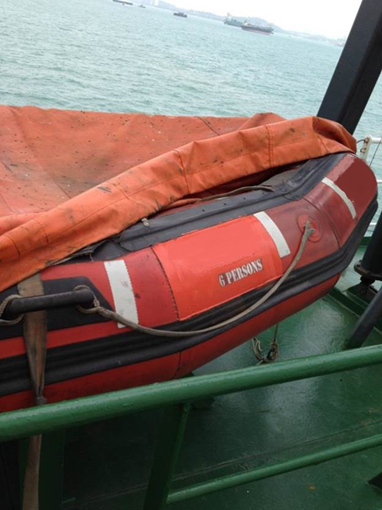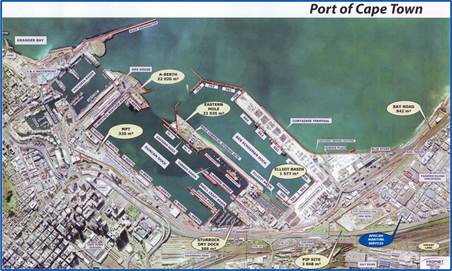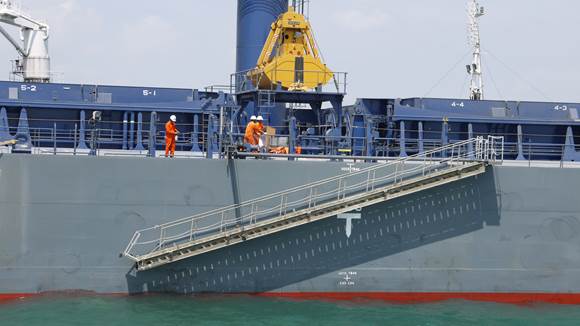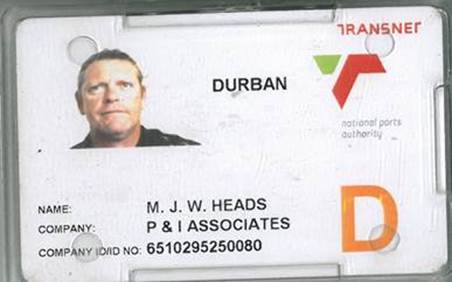Stowaways continue to present a serious risk for vessels calling at African ports. Many migrants seek to transit through South Africa and try to board ships calling at South African ports. Recent changes to local procedure will mean owners need to continue to proceed prudently and take steps to mitigate this risk.

Is someone on board? Lifeboats and ribs are a key place to check for stowaways (Source: Skuld)
Stowaways
Members calling at African ports will be familiar with the risk of stowaways seeking to gain access to vessels in the hope that they will be taken to Europe or North America. Many members will probably have had at least one experience of unauthorised persons seeking to gain access to their ship.
The dynamic and motivation for this situation remain unchanged, with migrants and possible asylum seekers still trying to reach new shores by way of commercial vessels. As such this risk persists, and members need to maintain their diligent approach to ship side security (and that is necessary for ISPS compliance in any event).
Recently Cape Town has adopted an approach to "classifying" such persons which is similar to that already practised in Durban.
This approach means that if an unauthorised person is found on board a vessel, then they will be classed as a "stowaway" rather than a "trespasser".
That is a significant difference.
If a person is found and declared to be a stowaway, then the vessel will be held responsible for the cost and liabilities of the disembarkation and repatriation of that person. On average it can cost USD17,000 to repatriate a person from South Africa back to Tanzania, where a lot of the people involved come from.
A vessel would have to prove that the person involved actually came on board at a South African port in order to have them classified as a "trespasser", in which case the vessel may not be held responsible for the follow on costs.
The Association's correspondents advise that the burden of proof can be very high in practice, as the authorities treat the stowaway's own statements with a high degree of suspicion about their origin and board of the ship.

Port of Cape Town (Source: P&I Associates)
Risk management
Given this development, the best and perhaps only line of defence is the vessel's gangway when at port in South Africa.
That means strict control of all persons coming on board, with production of a valid access permit.
The rule must be: no permit - no access.
Where situations are chaotic and / or many persons are seeking access at the same time, the master of the vessel needs to prioritise the safety of the vessel and her crew, as well ensure ISPS compliance is adhered to in practice.
If that means slowing things down or even calling a halt, then the master should do so. Absent particular charterparty provisions, such a step would not mean the vessel would be off-hire because of a step taken by the master to ensure the continued safety of the vessel and her crew.

Vessel's gangway - crew setting up to receive visitors at anchorage (Source: Skuld member)
Hot tip: the Association's correspondents have found that in many cases stowaways gained access to a vessel by simply walking up a gangway unchallenged or blending in to stevedore gangs.
Members would be prudent to undertake the following further steps in order to manage the risks of this issue:
- ensure there is advance understanding on the part of chartering and operations teams about the particular risks of any upcoming fixture or voyage
- charterparty terms should be clear about responsibility for cargo operations, stevedores and stowaways
- vessel's officers and crews should be briefed in advance about specific issues in respect to any given port of call
- ISPS compliance should be demonstrated in practice, and drills and exercise properly recorded in the vessel's logs
- latest information about port conditions should be sought in advance from local shipping agents
- the Ship Security Officer (SSO) should assess the situation and prepare the vessel in light of such updates
- vessel access control, in particular gangway checks should be planned and discussed with the crew in advance
- particular attention should be paid to the likely number and purpose of visitors and workers that may come to the vessel
- during time at anchorage and at berth, regular checks should be made against the presence of unauthorised persons on board
- prior to departure a further search should be undertaken
- if possible and available, a security company with search dogs should be used to check the vessel (but please keep in mind the sensitivities of any muslim seafarers on board)
If at any time there is concern, or should any attempt be witnessed of unauthorised persons seeking to come on board, then the master should make urgent contact with the Association's correspondents for further assistance.
If stowaways and trespassers are found, both correspondent and club should be contacted urgently.

Example of a Transnet ID card (Source: P&I Associates)
Further reading
The Association has published guidance and advisories on the issue of stowaways.
Members are also recommended to review the Association's ISPS advice, including the comprehensive guide.
For vessel specific enquiries, members are asked to contact their usual Skuld business unit.
The Association is grateful to correspondents P&I Associates for their assistance with this update.